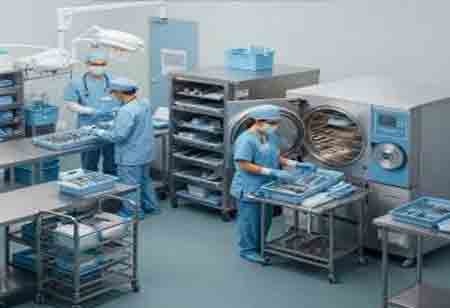Thank you for Subscribing to Healthcare Business Review Weekly Brief
Be first to read the latest tech news, Industry Leader's Insights, and CIO interviews of medium and large enterprises exclusively from Healthcare Business Review
Ensuring Safety: The Role of Sterile Processing in Modern Healthcare Systems
Sterile processing services play a critical role in healthcare by ensuring that surgical instruments and medical devices are cleaned, sterilized, and ready for safe use.

By
Healthcare Business Review | Thursday, April 17, 2025
Stay ahead of the industry with exclusive feature stories on the top companies, expert insights and the latest news delivered straight to your inbox. Subscribe today.
Sterile processing services play a critical role in healthcare by ensuring that surgical instruments and medical devices are cleaned, sterilized, and ready for safe use. Though often operating behind the scenes, this sector is fundamental to patient safety and the smooth functioning of hospitals, surgical centers, and clinics. The sterile processing field is transforming significantly as the healthcare industry grows more complex. Market trends, technological advancements, and evolving regulatory standards reshape how companies operate and invest. At the same time, staffing shortages and cost pressures push organizations to rethink their strategies.
Market Trends Driving Change
In the last few years, the demand for sterile processing services has grown due to the rise in surgical procedures, the aging global population, and heightened awareness of infection control. Much of this demand is being driven by outpatient surgical centers, which continue to expand as hospitals seek to reduce inpatient costs and shorten recovery times.
Another significant trend is the shift toward centralization and outsourcing. More healthcare providers are turning to third-party reprocessing services to reduce the burden on internal departments and ensure consistent sterilization quality. This is particularly common in systems struggling with labor shortages or lacking the infrastructure to meet increasingly stringent sterilization standards. In parallel, large hospital systems are investing in centralized sterile processing departments (CSPDs), which streamline workflows and improve compliance across multiple facilities.
Regulatory scrutiny is also increasing. In the U.S., the Centers for Medicare & Medicaid Services (CMS) and The Joint Commission emphasize sterilization protocols in their inspections. Globally, stricter standards from various national health authorities are prompting investment in compliant infrastructure and processes. This regulatory environment encourages stakeholders to take a more proactive and risk-based approach to sterile processing.
Technology and Process Innovations
Technological advancements are transforming sterile processing into a more precise and data-driven discipline. One of the most notable developments is integrating automation and tracking software. Modern sterile processing departments are adopting systems that automate sterilization cycles, monitor equipment performance, and track instrument usage throughout their lifecycle. These systems reduce human error and support regulatory compliance by maintaining detailed records.
Another major advancement is using radio-frequency identification (RFID) and barcode technology. These tools enhance inventory management and instrument traceability, critical in large surgical centers where tracking thousands of instruments can become a logistical nightmare. Automated cart washers, ultrasonic cleaners, and low-temperature sterilizers are also becoming standard in high-volume facilities, improving both efficiency and safety.
Artificial Intelligence (AI) and predictive analytics are also starting to find their place in sterile processing. For example, AI-powered platforms can predict instrument failure based on usage data, enabling preventive maintenance and reducing equipment downtime. These technologies are still emerging but represent a significant shift toward predictive and preventive approaches rather than reactive ones.
There is also an increased emphasis on sustainability. Traditionally, sterile processing is a resource-intensive operation that uses large amounts of water, energy, and packaging materials. In response, manufacturers are developing more eco-friendly sterilizers and reusable packaging systems, while healthcare providers are adopting green practices to minimize environmental impact without compromising safety.
Challenges and Opportunities Ahead
Despite these advancements, the industry faces several challenges. Labor shortages are at the top of the list. Sterile processing technicians require specialized training, and high turnover rates are common due to the demanding nature of the work. Many hospitals invest in workforce development programs, partner with community colleges, or offer on-the-job training to build a more stable talent pipeline. However, competition for skilled staff remains fierce, especially in urban centers and high-growth regions.
Another major issue is the rising cost of compliance. As regulations become more complex and audits more rigorous, healthcare providers must invest in upgraded facilities, software, and training programs. While this improves safety and accountability, it places a financial burden on smaller hospitals and clinics that may struggle to keep up. This is where strategic partnerships and outsourcing can help level the playing field by giving smaller players access to advanced technologies and expertise without the full upfront investment.
From an investment and growth standpoint, opportunities are strong for stakeholders who can offer scalable solutions. Companies that provide end-to-end sterile processing services, from equipment sales and maintenance to staff training and data analytics, are well-positioned for growth. There’s also room for innovation in mobile sterile processing units, particularly in underserved or remote areas with limited hospital infrastructure. These mobile units can help healthcare providers maintain high standards of sterilization without needing to build permanent facilities.
Private equity and venture capital are also showing increasing interest in the space. The predictable demand, essential nature of the services, and high barriers to entry make sterile processing an attractive niche within healthcare. Investment is flowing into tech-forward companies that can offer automation, cloud-based tracking, and compliance tools. Mergers and acquisitions are likely to continue as the industry consolidates and matures.






